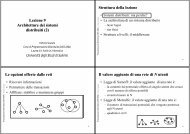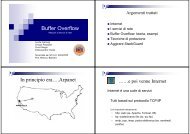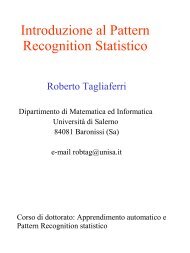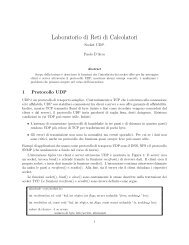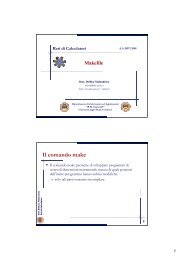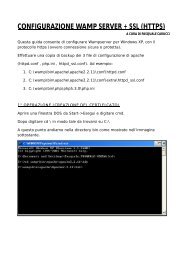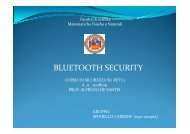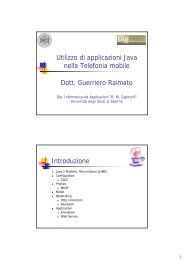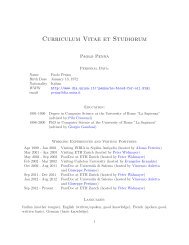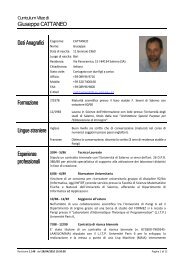Protocollo di Yao - Dipartimento di Informatica ed Applicazioni
Protocollo di Yao - Dipartimento di Informatica ed Applicazioni
Protocollo di Yao - Dipartimento di Informatica ed Applicazioni
Create successful ePaper yourself
Turn your PDF publications into a flip-book with our unique Google optimized e-Paper software.
Introduzione<br />
Visione fisica<br />
Implementazione Digitale<br />
Specifica del <strong>Protocollo</strong><br />
<strong>Protocollo</strong> <strong>di</strong> <strong>Yao</strong><br />
Secure Two-Party Computation<br />
Prof. Paolo D’Arco<br />
Università degli Stu<strong>di</strong> <strong>di</strong> Salerno<br />
Presentazione a cura <strong>di</strong> Michele Boccia e Francesco Matarazzo<br />
made with LATEX<br />
12 Giugno, 2012<br />
Prof. Paolo D’Arco <strong>Protocollo</strong> <strong>di</strong> <strong>Yao</strong> 1 / 32
Contenuti<br />
Introduzione<br />
Visione fisica<br />
Implementazione Digitale<br />
Specifica del <strong>Protocollo</strong><br />
Introduzione<br />
Problema dei Milionari<br />
Visione fisica<br />
Circuito<br />
Scatole<br />
Vasi Magici<br />
Implementazione Digitale<br />
Cifratura<br />
<strong>Protocollo</strong> OT 1-su-2<br />
Specifica del <strong>Protocollo</strong><br />
Prof. Paolo D’Arco <strong>Protocollo</strong> <strong>di</strong> <strong>Yao</strong> 2 / 32
Motivazioni<br />
Introduzione<br />
Visione fisica<br />
Implementazione Digitale<br />
Specifica del <strong>Protocollo</strong><br />
Problema dei Milionari<br />
◮ Chi è più ricco?<br />
◮ Nessuno dei due intende rivelare la propria ricchezza!<br />
Prof. Paolo D’Arco <strong>Protocollo</strong> <strong>di</strong> <strong>Yao</strong> 3 / 32
Motivazioni<br />
Introduzione<br />
Visione fisica<br />
Implementazione Digitale<br />
Specifica del <strong>Protocollo</strong><br />
Problema dei Milionari<br />
Prof. Paolo D’Arco <strong>Protocollo</strong> <strong>di</strong> <strong>Yao</strong> 4 / 32
Obiettivo<br />
Introduzione<br />
Visione fisica<br />
Implementazione Digitale<br />
Specifica del <strong>Protocollo</strong><br />
Problema dei Milionari<br />
◮ Vogliamo risolvere il problema senza l’uso <strong>di</strong> una parte<br />
fidata<br />
◮ Serve un protocollo che le due parti possano eseguire che<br />
emuli la presenza <strong>di</strong> una terza parte fidata<br />
Prof. Paolo D’Arco <strong>Protocollo</strong> <strong>di</strong> <strong>Yao</strong> 5 / 32
Problema Generale<br />
Introduzione<br />
Visione fisica<br />
Implementazione Digitale<br />
Specifica del <strong>Protocollo</strong><br />
Problema dei Milionari<br />
◮ Le due parti desiderano calcolare f (x, y) mantenendo i propri<br />
input x e y privati<br />
Prof. Paolo D’Arco <strong>Protocollo</strong> <strong>di</strong> <strong>Yao</strong> 6 / 32
Setting<br />
Introduzione<br />
Visione fisica<br />
Implementazione Digitale<br />
Specifica del <strong>Protocollo</strong><br />
◮ P1 ha input x ∈ {0, 1} n<br />
◮ P2 ha input y ∈ {0, 1} n<br />
◮ f : {0, 1} n × {0, 1} n → {0, 1} n<br />
Problema dei Milionari<br />
◮ P1 e P2 vogliono calcolare congiuntamente f (x, y), in modo<br />
tale che:<br />
⇒ la computazione <strong>di</strong>a f (x, y) e nessuna informazione sugli input<br />
x e y che non possa essere d<strong>ed</strong>otta dalla conoscenza <strong>di</strong> f (x, y)<br />
Prof. Paolo D’Arco <strong>Protocollo</strong> <strong>di</strong> <strong>Yao</strong> 7 / 32
Introduzione<br />
Visione fisica<br />
Implementazione Digitale<br />
Specifica del <strong>Protocollo</strong><br />
Circuito<br />
Scatole<br />
Vasi Magici<br />
◮ Una computazione può essere descritta in <strong>di</strong>versi mo<strong>di</strong>:<br />
⇒ Algoritmo espresso in co<strong>di</strong>ce/pseudoco<strong>di</strong>ce<br />
⇒ Macchina <strong>di</strong> Turing<br />
...<br />
⇒ Circuito Booleano → Scegliamo questa rappresentazione!<br />
◮ Supponiamo pertanto che la nostra f (x, y) sia rappresentata<br />
da un circuito C(x, y) con 2n fili <strong>di</strong> input <strong>ed</strong> n fili <strong>di</strong> output.<br />
◮ Supponiamo inoltre che ogni porta logica (AND, OR) abbia 2<br />
fili <strong>di</strong> input (fun in) e un filo <strong>di</strong> output (fun out)<br />
Prof. Paolo D’Arco <strong>Protocollo</strong> <strong>di</strong> <strong>Yao</strong> 8 / 32
Introduzione<br />
Visione fisica<br />
Implementazione Digitale<br />
Specifica del <strong>Protocollo</strong><br />
Circuito<br />
Scatole<br />
Vasi Magici<br />
◮ Dato un circuito C(x, y) che calcola f (x, y), applicando ai fili<br />
<strong>di</strong> input i valori <strong>di</strong> x e y, e propagando i valori dalle porte del<br />
primo livello fino alle porte dell’ultimo livello, si ottiene il<br />
valore <strong>di</strong> output, cioè f (x, y)<br />
Prof. Paolo D’Arco <strong>Protocollo</strong> <strong>di</strong> <strong>Yao</strong> 9 / 32
Introduzione<br />
Visione fisica<br />
Implementazione Digitale<br />
Specifica del <strong>Protocollo</strong><br />
Circuito<br />
Scatole<br />
Vasi Magici<br />
◮ Tuttavia, volendo preservare la privacy degli input, nessuna<br />
delle due parti può dare il proprio input in chiaro per calcolare<br />
il circuito<br />
◮ Idea: piuttosto che effettuare la computazione sui bit in<br />
chiaro, vogliamo effettuare la computazione usando valori<br />
casuali che non danno informazioni sui bit cui però sono<br />
associati<br />
Ci torneremo più tar<strong>di</strong>...<br />
Ragioniamo in termini <strong>di</strong> chiavi e lucchetti fisici!<br />
Prof. Paolo D’Arco <strong>Protocollo</strong> <strong>di</strong> <strong>Yao</strong> 10 / 32
Introduzione<br />
Visione fisica<br />
Implementazione Digitale<br />
Specifica del <strong>Protocollo</strong><br />
Circuito<br />
Scatole<br />
Vasi Magici<br />
◮ Diamo un nome ad ogni filo del circuito: ω1, ω2...<br />
◮ Sia ω un filo generico<br />
◮ Associamo a ω due chiavi K 0 ω e K 1 ω, che rappresentano 0 e 1.<br />
◮ Consideriamo una generica porta logica, per esempio una<br />
porta OR:<br />
Prof. Paolo D’Arco <strong>Protocollo</strong> <strong>di</strong> <strong>Yao</strong> 11 / 32
Introduzione<br />
Visione fisica<br />
Implementazione Digitale<br />
Specifica del <strong>Protocollo</strong><br />
Circuito<br />
Scatole<br />
Vasi Magici<br />
◮ Associamo alla porta 4 scatole doppie, una interna <strong>ed</strong> una<br />
esterna, chiuse con due lucchetti che necessitano <strong>di</strong> due chiavi<br />
<strong>di</strong>verse per essere aperti<br />
◮ La scatola interna contiene una copia <strong>di</strong> K 0 ω o <strong>di</strong> K 1 ω<br />
Prof. Paolo D’Arco <strong>Protocollo</strong> <strong>di</strong> <strong>Yao</strong> 12 / 32
Introduzione<br />
Visione fisica<br />
Implementazione Digitale<br />
Specifica del <strong>Protocollo</strong><br />
Circuito<br />
Scatole<br />
Vasi Magici<br />
◮ In particolare, le 4 scatole per una porta OR sono costruite<br />
come segue:<br />
ω1 ω2 bit OR ω3<br />
K 0 ω1 K 0 ω2 0,0 0 K 0 ω3<br />
K 0 ω1 K 1 ω2 0,1 1 K 1 ω3<br />
K 1 ω1 K 0 ω2 1,0 1 K 1 ω3<br />
K 1 ω1 K 1 ω2 1,1 1 K 1 ω3<br />
◮ Le scatole doppie vengono permutate a caso<br />
Prof. Paolo D’Arco <strong>Protocollo</strong> <strong>di</strong> <strong>Yao</strong> 13 / 32
Introduzione<br />
Visione fisica<br />
Implementazione Digitale<br />
Specifica del <strong>Protocollo</strong><br />
Circuito<br />
Scatole<br />
Vasi Magici<br />
◮ Ogni coppia <strong>di</strong> chiavi apre una <strong>ed</strong> una sola scatola doppia<br />
◮ Se le due parti, P1 e P2, hanno una sola chiave per ogni filo <strong>di</strong><br />
input, possono ottenere una sola chiave dall’apertura <strong>di</strong> ogni<br />
scatola doppia associata ad ogni porta <strong>di</strong> primo livello<br />
◮ Con le chiavi ottenute aprendo le scatole del primo livello, si<br />
possono aprire le scatole associate alle porte del secondo<br />
livello (una <strong>ed</strong> una sola per ogni porta) e, iterando il processo,<br />
si può ottenere una <strong>ed</strong> una sola chiave per ogni filo <strong>di</strong> output,<br />
fili associati alle porte dell’ultimo livello<br />
Prof. Paolo D’Arco <strong>Protocollo</strong> <strong>di</strong> <strong>Yao</strong> 14 / 32
Introduzione<br />
Visione fisica<br />
Implementazione Digitale<br />
Specifica del <strong>Protocollo</strong><br />
Circuito<br />
Scatole<br />
Vasi Magici<br />
◮ Le chiavi dei fili <strong>di</strong> output del circuito aprono scatole singole<br />
contenenti 0 o 1:<br />
Prof. Paolo D’Arco <strong>Protocollo</strong> <strong>di</strong> <strong>Yao</strong> 15 / 32
Introduzione<br />
Visione fisica<br />
Implementazione Digitale<br />
Specifica del <strong>Protocollo</strong><br />
Circuito<br />
Scatole<br />
Vasi Magici<br />
◮ Pertanto, supponendo che una parte fidata costruisca il<br />
circuito C(x, y) che calcola f (x, y), costruisca le scatole<br />
doppie per ogni porta e <strong>di</strong>a a P1 e P2 le chiavi fisiche dei fili<br />
<strong>di</strong> input a seconda dei rispettivi valori <strong>di</strong> x e <strong>di</strong> y, allora P1 e<br />
P2 sono in grado <strong>di</strong> aprire le scatole doppie in successione e<br />
ottenere il valore della funzione, che si trova nelle scatole<br />
singole finali<br />
Prof. Paolo D’Arco <strong>Protocollo</strong> <strong>di</strong> <strong>Yao</strong> 16 / 32
Esempio<br />
◮ n = 4<br />
◮ x = 0100<br />
◮ y = 1101<br />
Introduzione<br />
Visione fisica<br />
Implementazione Digitale<br />
Specifica del <strong>Protocollo</strong><br />
Circuito<br />
Scatole<br />
Vasi Magici<br />
Chiavi <strong>di</strong> P1 = K 0 ω1 , K 1 ω2 , K 0 ω3 , K 0 ω4<br />
Chiavi <strong>di</strong> P2 = K 1 ω5 , K 1 ω6 , K 0 ω7 , K 1 ω8<br />
...ma non vogliamo la parte fidata!!!<br />
Se l’avessimo, non avremmo bisogno <strong>di</strong> mettere in pie<strong>di</strong> un<br />
meccanismo così articolato...<br />
Come facciamo?<br />
Prof. Paolo D’Arco <strong>Protocollo</strong> <strong>di</strong> <strong>Yao</strong> 17 / 32
Idea<br />
Introduzione<br />
Visione fisica<br />
Implementazione Digitale<br />
Specifica del <strong>Protocollo</strong><br />
Circuito<br />
Scatole<br />
Vasi Magici<br />
◮ P1 costruisce il circuito C(x, y) che calcola f (x, y) <strong>ed</strong> in<br />
accordo ad esso la sequenza <strong>di</strong> scatole<br />
◮ P1 possi<strong>ed</strong>e tutte le chiavi e vuole far eseguire la<br />
computazione a P2<br />
◮ P1 invia le chiavi K 0 ω1 , K 1 ω2 , K 0 ω3 , K 0 ω4 che corrispondono al suo<br />
input a P2. Si noti che le chiavi sono solo pezzi <strong>di</strong> ferro e non<br />
danno informazioni sui bit cui sono associate<br />
Prof. Paolo D’Arco <strong>Protocollo</strong> <strong>di</strong> <strong>Yao</strong> 18 / 32
Problema<br />
Introduzione<br />
Visione fisica<br />
Implementazione Digitale<br />
Specifica del <strong>Protocollo</strong><br />
Circuito<br />
Scatole<br />
Vasi Magici<br />
◮ Come fa P1 a dare a P2 le chiavi associate all’input <strong>di</strong> P2?<br />
1. Soluzione: P2 comunica a P1 il valore y! Privacy persa!!!<br />
2. Soluzione: P1 le invia tutte: K 0 ω5 K 1 ω5 , K 0 ω6 K 1 ω6 . . . K 0 ω8 K 1 ω8<br />
P2 può aprire <strong>di</strong>verse scatole e quin<strong>di</strong> calcolare non solo<br />
C(x, y) ma C(x, ¯y) per ogni ¯y ∈ {0, 1} 4 !!!<br />
Non va bene...<br />
Prof. Paolo D’Arco <strong>Protocollo</strong> <strong>di</strong> <strong>Yao</strong> 19 / 32
Introduzione<br />
Visione fisica<br />
Implementazione Digitale<br />
Specifica del <strong>Protocollo</strong><br />
Circuito<br />
Scatole<br />
Vasi Magici<br />
◮ Occorre quin<strong>di</strong> un metodo attraverso il quale P1 permette a<br />
P2 <strong>di</strong> scegliere le chiavi che corrispondono al proprio input,<br />
senza che però P1 sappia quali ha scelto!!!<br />
Prof. Paolo D’Arco <strong>Protocollo</strong> <strong>di</strong> <strong>Yao</strong> 20 / 32
Come si fa?<br />
Introduzione<br />
Visione fisica<br />
Implementazione Digitale<br />
Specifica del <strong>Protocollo</strong><br />
Circuito<br />
Scatole<br />
Vasi Magici<br />
◮ P1 <strong>di</strong>spone <strong>di</strong> un Vaso Magico che può contenere due chiavi,<br />
con due proprietà:<br />
1. Una volta inserite le due chiavi, P1 non le può più recuperare<br />
2. Il vaso magico ha un foro che permette a P2 <strong>di</strong> recuperare una<br />
sola delle chiavi, a sua scelta. Una volta estratta, il vaso si<br />
chiude ermeticamente<br />
Prof. Paolo D’Arco <strong>Protocollo</strong> <strong>di</strong> <strong>Yao</strong> 21 / 32
Introduzione<br />
Visione fisica<br />
Implementazione Digitale<br />
Specifica del <strong>Protocollo</strong><br />
Circuito<br />
Scatole<br />
Vasi Magici<br />
◮ Per esempio, supponendo che le chiavi introdotte abbiano<br />
un’etichetta che al tatto rivela se corrisponde ad un bit 0 o 1,<br />
P2 può estrarre quella che corrisponde al proprio bit!<br />
◮ In questo modo P2 ne prende una <strong>ed</strong> una soltanto e P1 non<br />
sapra‘ quale ha preso<br />
Prof. Paolo D’Arco <strong>Protocollo</strong> <strong>di</strong> <strong>Yao</strong> 22 / 32
Riassumendo<br />
Introduzione<br />
Visione fisica<br />
Implementazione Digitale<br />
Specifica del <strong>Protocollo</strong><br />
Cifratura<br />
<strong>Protocollo</strong> OT 1-su-2<br />
◮ P1 prepara il circuito, le scatole e gli n vasi magici<br />
◮ P1 manda a P2 le chiavi che corrispondono al proprio input<br />
◮ P2 recupera dai vasi magici le chiavi associate al proprio input<br />
che, insieme a quelle che P1 gli ha inviato, gli permettono <strong>di</strong><br />
aprire in successione tutte le scatole associate alle porte del<br />
circuito e <strong>di</strong> ottenere il valore <strong>di</strong> output f (x, y)<br />
◮ P2 invia f (x, y) a P1 o le chiavi dell’ultimo livello per<br />
permettere a P1 stesso <strong>di</strong> aprire le scatole singole<br />
La computazione non rivela informazioni sugli input <strong>di</strong> P1 e <strong>di</strong> P2.<br />
Pertanto la privacy è preservata<br />
Prof. Paolo D’Arco <strong>Protocollo</strong> <strong>di</strong> <strong>Yao</strong> 23 / 32
Scatole in <strong>di</strong>gitale...<br />
◮ E K 0 ω1<br />
(EK 1 (K<br />
ω2<br />
1 ω3 ))<br />
Introduzione<br />
Visione fisica<br />
Implementazione Digitale<br />
Specifica del <strong>Protocollo</strong><br />
Cifratura<br />
<strong>Protocollo</strong> OT 1-su-2<br />
◮ Cifratura con decifratura ”non ambigua”<br />
◮ 4 scatole ≡ 4 cifrature doppie, C0, C1, C2, C3, permutate a<br />
caso<br />
Prof. Paolo D’Arco <strong>Protocollo</strong> <strong>di</strong> <strong>Yao</strong> 24 / 32
Introduzione<br />
Visione fisica<br />
Implementazione Digitale<br />
Specifica del <strong>Protocollo</strong><br />
Vasi Magici in <strong>di</strong>gitale...<br />
◮ <strong>Protocollo</strong> Oblivious Transfer 1-su-2<br />
Cifratura<br />
<strong>Protocollo</strong> OT 1-su-2<br />
Sender Receiver<br />
INPUT m0 b ∈ 0, 1<br />
m1<br />
OUTPUT ⊥ mb<br />
Prof. Paolo D’Arco <strong>Protocollo</strong> <strong>di</strong> <strong>Yao</strong> 25 / 32
Introduzione<br />
Visione fisica<br />
Implementazione Digitale<br />
Specifica del <strong>Protocollo</strong><br />
Cifratura<br />
<strong>Protocollo</strong> OT 1-su-2<br />
◮ Sia F = {fK }K una famiglia <strong>di</strong> funzioni pseudo-casuali (PRF<br />
in breve) tali che<br />
f K∈{0,1} n : {0, 1} n → {0, 1} 2n<br />
◮ La cifratura può essere realizzata come segue<br />
EK (x) = (r, fK (r) ⊕ x0 n )<br />
dove x ∈ {0, 1} n e r ∈ {0, 1} n scelto uniformemente a caso<br />
◮ Chi decifra (r, c), calcola fK (r) ⊕ c = fK (r) ⊕ (fK (r) ⊕ x0n) e<br />
controlla la correttezza dell’operazione verificando che il<br />
messaggio ottenuto abbia n bit uguali a 0 alla fine<br />
Prof. Paolo D’Arco <strong>Protocollo</strong> <strong>di</strong> <strong>Yao</strong> 26 / 32
Introduzione<br />
Visione fisica<br />
Implementazione Digitale<br />
Specifica del <strong>Protocollo</strong><br />
Cifratura<br />
<strong>Protocollo</strong> OT 1-su-2<br />
Che cos’è una famiglia <strong>di</strong> funzioni Pseudo-casuali?<br />
◮ Un osservatore che riesce a fare solo “computazioni efficienti”<br />
(randomizzate e che richi<strong>ed</strong>ono tempo polinominale) non<br />
riesce a capire, con probabilità significativamente superiore ad<br />
1<br />
2 , se nella scatola c’è fk() o r()<br />
Prof. Paolo D’Arco <strong>Protocollo</strong> <strong>di</strong> <strong>Yao</strong> 27 / 32
Introduzione<br />
Visione fisica<br />
Implementazione Digitale<br />
Specifica del <strong>Protocollo</strong><br />
Oblivious Transfer: idea<br />
Cifratura<br />
<strong>Protocollo</strong> OT 1-su-2<br />
Sender Receiver<br />
(PK0 , PK1 )<br />
DGGGGGGGGGGGGGGGG<br />
EPK 0 (m0), EPK 1 (m1)<br />
GGGGGGGGGGGGGGGGGGGGGGGGA<br />
◮ Il receiver possi<strong>ed</strong>e due chiavi pubbliche PK0 e PK1 , ma una<br />
sola chiave privata, per esempio, SK0 associata a PK0 .<br />
Pertanto, a seconda del messaggio che vuole ottenere, le invia<br />
nell’or<strong>di</strong>ne opportuno. Così riesce a decifrare il messaggio che<br />
desidera e solo quello<br />
Prof. Paolo D’Arco <strong>Protocollo</strong> <strong>di</strong> <strong>Yao</strong> 28 / 32
Introduzione<br />
Visione fisica<br />
Implementazione Digitale<br />
Specifica del <strong>Protocollo</strong><br />
Cifratura<br />
<strong>Protocollo</strong> OT 1-su-2<br />
OT: istanza usando il crittosistema <strong>di</strong> ElGamal<br />
◮ Sia (G, q, g) un gruppo <strong>di</strong> or<strong>di</strong>ne primo q con generatore g<br />
E(m0) = (g r0 , (PK0) r0 ⊕ m0) = (g r0 , c0)<br />
E(m1) = (g r1 , (PK1) r1 ⊕ m1) = (g r1 , c1)<br />
Prof. Paolo D’Arco <strong>Protocollo</strong> <strong>di</strong> <strong>Yao</strong> 29 / 32
Introduzione<br />
Visione fisica<br />
Implementazione Digitale<br />
Specifica del <strong>Protocollo</strong><br />
Come il Receiver calcola mσ?<br />
Cifratura<br />
<strong>Protocollo</strong> OT 1-su-2<br />
◮ Calcola (g rσ ) K = (g K ) rσ = (PKσ) rσ e quin<strong>di</strong>:<br />
⇒ Cσ<br />
(g rσ )K = (PKσ)rσ ⊕mσ<br />
(PKσ) rσ<br />
= mσ<br />
◮ Perchè non riesce a calcolare m1−σ? Intuizione...<br />
⇒ Nota che C = g S per qualche S ∈ Zq<br />
⇒ Se il DLP è <strong>di</strong>fficile, il Receiver non riesce a calcolarlo<br />
⇒ Pertanto non può calcolare (PK1−σ) r1−σ = (g r1−σ ) S−K per<br />
recuperare m1−σ<br />
Prof. Paolo D’Arco <strong>Protocollo</strong> <strong>di</strong> <strong>Yao</strong> 30 / 32
Introduzione<br />
Visione fisica<br />
Implementazione Digitale<br />
Specifica del <strong>Protocollo</strong><br />
<strong>Protocollo</strong> <strong>di</strong> <strong>Yao</strong>: passi<br />
◮ Input: P1 ha x ∈ {0, 1} n , P2 ha y ∈ {0, 1} n<br />
◮ Input ausiliario: Circuito booleano C tale che ∀x, y ∈ {0, 1} n ,<br />
risulta C(x, y) = f (x, y) dove<br />
f : {0, 1} n × {0, 1} n → {0, 1} n<br />
<strong>Protocollo</strong>:<br />
1. P1 costruisce il circuito cifrato G(C(x, y))<br />
2. Siano ω1, ω2 . . . ωn i fili <strong>di</strong> input associati a x1, x2 . . . xn e<br />
ωn+1 . . . ω2n i fili <strong>di</strong> input associati a y1, y2 . . . yn:<br />
2.1 P1 invia a P2 le chiavi K x1<br />
1<br />
. . . K xn<br />
n<br />
2.2 Per i = 1, . . . , n, P1 e P2 eseguono OT 1-su-2 in cui i segreti <strong>di</strong><br />
P1 sono (K 0 n+i , K 1 n+i ) e il bit <strong>di</strong> scelta <strong>di</strong> P2 è yi<br />
3. P2, ottenuto il circuito G(C(x, y)) e le chiavi associate ai fili<br />
<strong>di</strong> input, calcola il circuito e ottiene f (x, y). Infine, invia<br />
f (x, y) a P1<br />
Prof. Paolo D’Arco <strong>Protocollo</strong> <strong>di</strong> <strong>Yao</strong> 31 / 32
Riferimenti<br />
Y. Lindell and B. Pinkas,<br />
A Proof of Security of <strong>Yao</strong>’s Protocol for Two-Party<br />
Computation, Journal of Cryptology, n. 22, pp. 161-188, 2009<br />
M. Naor, Foundations of Cryptography, Lecture 15: Oblivious<br />
Transfer and Secure Function Evaluation, reperibile al sito<br />
http://www.wisdom.weizmann.ac.il/~naor/



